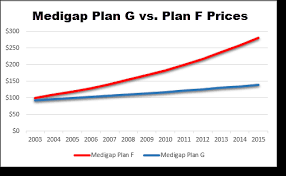Are you wondering should I choose Plan F or Plan G? This clear, concise summary is for you.
Before you choose a Medigap plan, it is crucial to understand the basic tenet of Medigap plans – that is that the plans are Federally-standardized. In other words, a Plan F with one company is the exact same as a Plan F with a different company. The only comparison factors are PRICE and company REPUTATION. So, which is the best Medigap plan for you?
First and foremost, it is important to understand who is even eligible for a Plan F. Plan F was phased out with those first eligible for Medicare after 1/1/2020. So, if you went on Medicare in 2020 or after, Plan F is no longer available to you and Plan G is the most comprehensive Medigap plan available.
What Do Plan F and Plan G Cover?
The Federal Medigap coverage chart shows what each plan covers. In summary, Plan F is the most comprehensive plan – it pays everything that Medicare Part A (hospital) and Part B (doctor/outpatient) do not cover. With Plan F, you have no out of pocket costs, no co-pays or deductibles to pay.
Plan G is almost identical to Plan F, with only one exception. That exception is that Plan G does not cover the Medicare Part B deductible. For 2025, the Medicare Part B deductible is $257/year. All other benefits are identical to Plan F. The only out of pocket cost you would face under Plan G would be the $257/year Part B deductible.
How Should You Choose Between Plan F or Plan G?
It is a pretty straight-forward mathematical calculation. If the premium savings on ‘G’ are greater than the deductible amount, then ‘G’ makes more sense than ‘F’. Often, the premium differences between these two plans are $300/year or more. In some cases, the premium difference can be as much as $500/year, making ‘G’ a “no-brainer”.
Ideally, you should obtain quotes for both Plan F and Plan G and compare premiums on those two plans. In some states and situations, the premium difference may only be $10-12/month. In that situation, Plan F could be a more viable option. But, if the premium difference is $21.42/month ($257/year) or more, it makes sense to save money on premium and pay the annual Medicare deductible yourself. You can get Medigap quotes by email here.
What Other Considerations Are There When Choosing Between Plan F or Plan G?
 There are a couple of other considerations when choosing between Plan F or Plan G. First of all, there is the fact that Plan F is ending in 2020. This will likely lead to future rate instability on that plan, at least as compared to Plan G, when there are no future enrollments allowed into Plan F. Although you were able to keep your Plan F after 2020, rates will not likely be as stable, so you may not want to do so.
There are a couple of other considerations when choosing between Plan F or Plan G. First of all, there is the fact that Plan F is ending in 2020. This will likely lead to future rate instability on that plan, at least as compared to Plan G, when there are no future enrollments allowed into Plan F. Although you were able to keep your Plan F after 2020, rates will not likely be as stable, so you may not want to do so.
Secondly, Plan G is already more rate-stable, historically speaking. Plan F is offered in certain “guaranteed issue” situations (i.e. losing group coverage, moving to a new state with an Advantage plan, losing Medicare Advantage coverage, etc.).
In these situations, insurance companies cannot use medical  underwriting to screen applicants. Over time and large numbers, this leads to greater claims ratios on Plan F, and subsequently, larger/more frequent rate increases on Plan F. This is not the case on Plan G, as this plan is not one of the plans offered in a “guaranteed issue” situation.
underwriting to screen applicants. Over time and large numbers, this leads to greater claims ratios on Plan F, and subsequently, larger/more frequent rate increases on Plan F. This is not the case on Plan G, as this plan is not one of the plans offered in a “guaranteed issue” situation.
NOTE: For those that turned 65 after 1/1/2020, the above does not apply. For those individuals, Plan F is not available at all and Plan G is the most comprehensive plan offered in “guaranteed issue” situations.
In the past, this has led to increases of a few percentage points more on ‘F’ than on ‘G’ with most companies. Although a couple of percentage points does not sound like a big difference, this can really add up over time, making ‘G’ an even more prudent choice.
If you have questions about Medigap Plan F or Plan G, or anything else related to your transition to Medicare, you can contact us at 877.506.3378 or ask your Medicare question online for a response by email.

